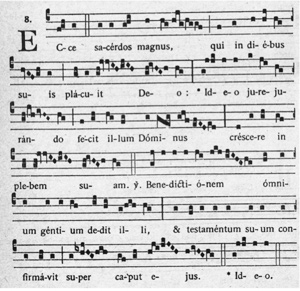Gregorian chant notated by neumes
Medieval Europe, with its different forms of music, also gave birth to the foundations for the musical notation that we are familiar with today. Early medieval music did not use any form of musical notation. The pieces were memorized and played by ear. Since they were monophonic and fairly simple, musicians were better able to remember them. One of the notation techniques that developed was neumes, which were signs written above the chant words to indicate where the voices should rise and where they should fall in tone. In their early use, neumes gave some information about the melody to be followed, but the signs did not indicate the exact rhythm or note. Later examples of neumes would begin to incorporate information about the note and the rhythm of the melody. Neumes would be the primary system of musical notation until the five-line staff musical notation that we see today.
One of the effects of increasing musical notation was that individual composers gained more recognition for their work. Before notation was widely used, pieces of music were passed along only through memorization of live performances. This often meant that the composer was forgotten as the music was played and spread. Once musical notation began to be used more widely, the composer's name was noted with the musical piece. This led to greater recognition for composers as their names started to be associated with particular pieces of music. Perhaps one of the first composers to benefit greatly from this was Guillaume de Machaut, who lived from 1300 to 1377. Both a poet and composer, Machaut wrote over one hundred songs and was one of the first to write polyphonic music. He would play an important role in the rise of musical forms, such as the motet (a type of vocal music).
In this unit, we traced the development of music from prehistoric days to medieval times. We discussed how music might have developed during prehistoric times and learned about some archaeological finds that give us more information about the instruments and music of preliterate societies. We also learned more about the music of ancient societies including the Egyptians and Greeks. We examined some of the different musical forms, instruments, and approaches to music that these different societies had. Finally, we turned to the music of the Middle Ages and examined some of the different forms of music that were popular during this time period. We also discussed how the use of musical notation affected music and composers.
Think About
- How did music first develop?
- What roles did music have in prehistoric and ancient societies?
- How did different ancient societies adapt their own music?
- How did music change from prehistoric times through medieval times?
- What was medieval music like? What characteristics did it have?
Journal Activity: Answer these questions in your journal.
